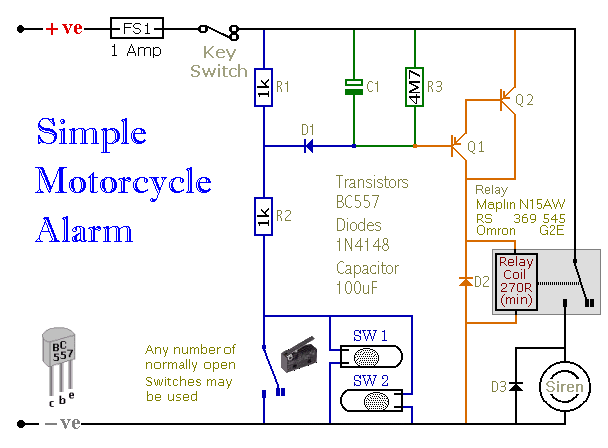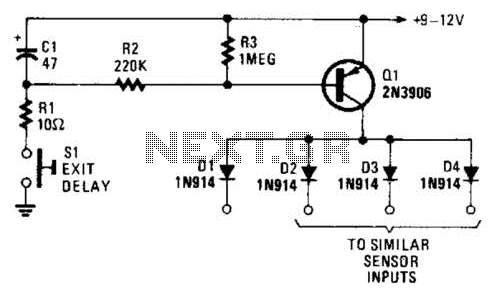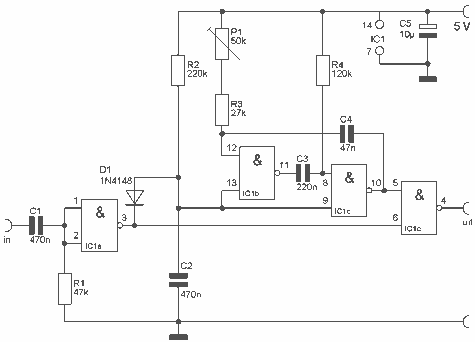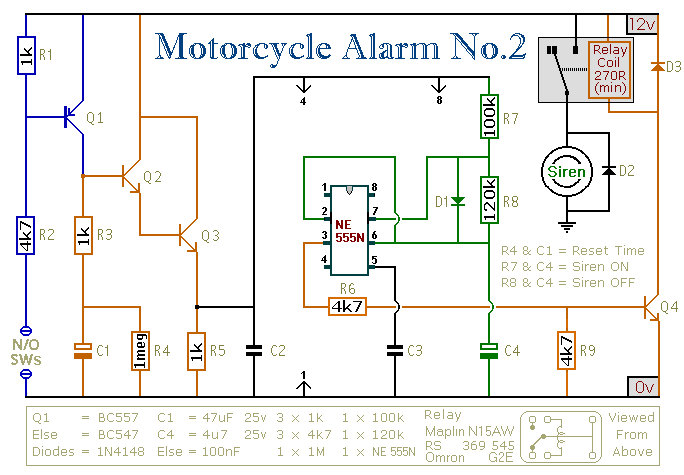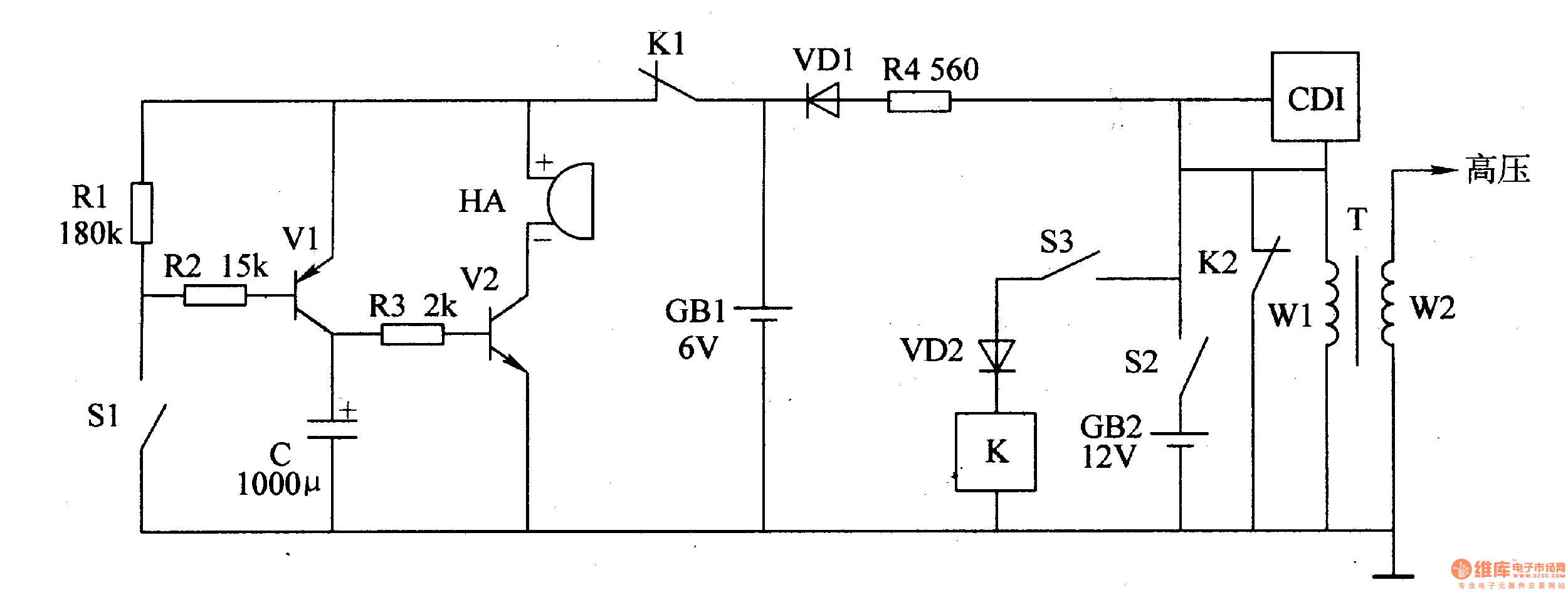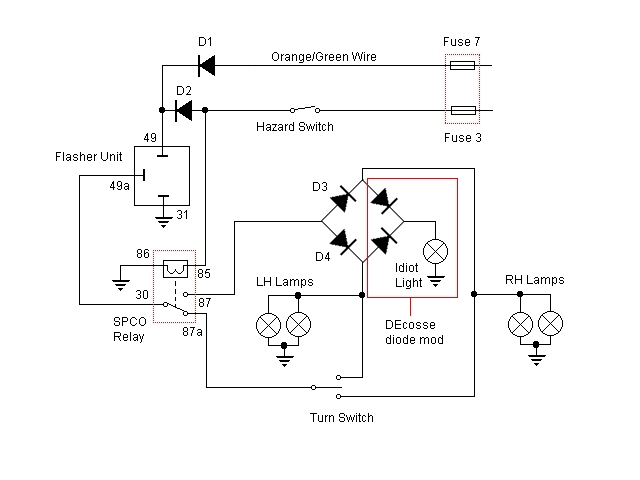
motorcycle alarms numbers
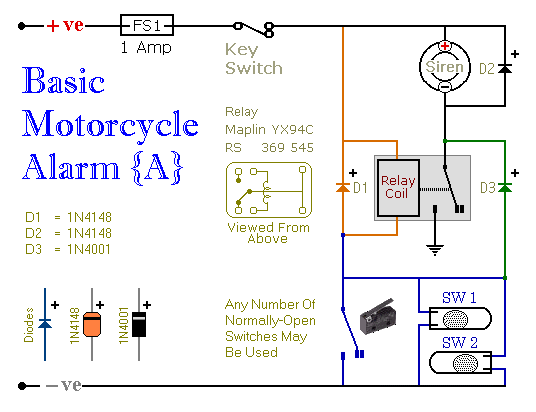
These are two easy-to-build relay-based alarms that can be used to protect motorcycles, among other applications. Using relays with 6-volt coils will safeguard a "Classic Bike." Both alarms are compact, with completed boards occupying approximately half a cubic inch (8 cc). The standby current is zero, ensuring that they will not drain the battery. Circuit Number Five utilizes a SPCO/SPDT relay, but a SPST relay is sufficient. If using the provided veroboard layout, the specified relay style is necessary; however, any available relay style can be used. Multiple normally-open switches can be incorporated. Position mercury switches to close when the steering is moved, or when the bike is lifted off its side-stand or pushed off its center-stand. Micro-switches can be used to secure removable panels and the lids of panniers. When a trigger-switch is closed, the relay will energize, activating the siren. The subsequent behavior can be configured; with the circuit built as shown, the siren will sound continuously until manually turned off or until the battery is depleted. Omitting D3 will cause the siren to stop immediately when the trigger-switch is reopened. The former configuration is preferable when in earshot of the machine, while the latter is suitable for longer absences to minimize disturbance. Including a SPST switch in series with D3 allows for behavior selection based on circumstances. Relay coils and some sounders may generate high reverse-voltage spikes, which can damage sensitive electronic components. D1 and D2 are included to short-circuit these spikes as a precaution, given the potential connection to other electronic equipment on the same power supply. If no sensitive equipment is present, the diodes can be omitted. Circuit Number Six employs a DPCO/DPDT relay, but a DPST relay is adequate. The same guidelines for switch placement and siren behavior apply as in Circuit Number Five, with the added option to connect a SPST switch in place of the solder-bridge to customize behavior. Regardless of the alarm built, the circuit board and switches must be protected from moisture to prevent damage. A 1-amp in-line fuse should be positioned close to the power source to protect the wiring rather than the circuit board. Instead of a key-switch, a hidden switch or normally-closed contacts of a small relay can be used, with the relay coil energized while the ignition is on, allowing the alarm to set itself when the ignition is turned off. The alarms consume no current when not sounding, making them suitable for use in situations where a power supply is not readily available. They can be powered by dry batteries, with relay and siren voltages adjusted accordingly. The support material for these alarms includes a detailed guide for constructing the circuit board, a parts list, a complete circuit description, and additional resources.
The relay-based alarm circuits described are designed for versatility and ease of construction, making them suitable for various applications beyond motorcycle security. The compact nature of the boards allows for discreet installation, and the zero standby current ensures that the battery life is preserved. The choice of relay type provides flexibility in design, accommodating different user preferences and available components.
In both circuits, the use of mercury switches or micro-switches allows for tailored triggering mechanisms, ensuring that the alarm system is responsive to specific movements or unauthorized access. The option to configure the siren behavior—either continuous or momentary—adds a layer of customization, enabling the user to adapt the alarm system to their environment and preferences.
The inclusion of protective diodes (D1 and D2) is a critical design consideration, safeguarding the circuit from voltage spikes that could arise from relay actuation or sounder operation. This precaution is particularly important in systems where multiple electronic devices may share a power supply, ensuring that the integrity of all components is maintained.
The recommendation for moisture protection emphasizes the need for durability in outdoor environments. The installation of a fuse close to the power source is a standard practice in circuit design, ensuring that the wiring is protected from overcurrent situations, which could lead to potential hazards.
This alarm system can be adapted for various power sources, including dry batteries, making it versatile for different scenarios. The comprehensive support material provided with the alarm kits enhances the user experience, guiding the builder through the assembly process while ensuring that all necessary components are accounted for. Overall, these relay-based alarms represent an effective solution for securing motorcycles and other valuable assets.These are two - easy to build - relay-based alarms. You can use them to protect your motorcycle - but they have many more applications. If you use relays with 6-volt coils - they`ll protect your "Classic Bike". Both alarms are very small. The completed boards occupy about half a cubic-inch - 8 cc. The standby current is zero - so they won`t drain your battery. Circuit Number Five uses a SPCO/SPDT relay - but you really only need to use a SPST relay. If you are going to use the veroboard layout provided - you`ll need to use the style of relay specified. But you can build the alarm using whatever style of relay you have available. Any number of normally-open switches may be used. Fit the mercury switches so that they close when the steering is moved or when the bike is lifted off its side-stand or pushed forward off its centre-stand.
Use micro-switches to protect removable panels and the lids of panniers etc. When one of the trigger-switches is closed - the relay will energize and the siren will sound. You can choose what happens next. If you build the circuit as shown, the siren will continue to sound until you turn it off - or until the battery is exhausted. But, if you leave out D3 - the siren will stop sounding immediately the trigger-switch is re-opened. While you`re within earshot of your machine - the former configuration is best. You can always turn off the alarm yourself. But if you are going to be away from your bike for any length of time - and you don`t want to cause a nuisance - then the latter configuration is probably more suitable.
If you include a SPST switch in series with D3 - you can select the behaviour that best suits the circumstances at any given time. Relay coils and some sounders produce high reverse-voltage spikes that will destroy sensitive electronic components.
D1 and D2 are there to short-circuit these spikes before they can do any damage. Although there is nothing in the alarm circuit itself that could be damaged - I have no idea what other electronic equipment might be connected to the same power supply. So I included the two diodes as a precaution. If you`re satisfied that there`s nothing on your bike that might be damaged in this way - you can leave out the two diodes.
Circuit Number Six uses a DPCO/DPDT relay - but you really only need to use a DPST relay. If you are going to use the veroboard layout provided - you`ll need to use the style of relay specified. But you can build the alarm using whatever style of relay you have available. Any number of normally-open switches may be used. Fit the mercury switches so that they close when the steering is moved or when the bike is lifted off its side-stand or pushed forward off its centre-stand.
Use micro-switches to protect removable panels and the lids of panniers etc. When one of the trigger-switches is closed - the relay will energize and the siren will sound. You can choose what happens next. If you build the circuit as shown, the siren will continue to sound until you turn it off - or until the battery is exhausted. But, if you leave out the (yellow) solder-bridge in the top left-hand corner - the siren will stop sounding immediately the trigger-switch is re-opened.
While you`re within earshot of your machine - the former configuration is best. You can always turn off the alarm yourself. But if you are going to be away from your bike for any length of time - and you don`t want to cause a nuisance - then the latter configuration is probably more suitable. Connect a SPST switch in place of the (yellow) solder-bridge - and you can select the behaviour that best suits the circumstances at any given time.
Relay coils and some sounders produce high reverse-voltage spikes that will destroy sensitive electronic components. D1 and D2 are there to short-circuit these spikes before they can do any damage. Although there is nothing in the alarm circuit itself that could be damaged - I have no idea what other electronic equipment might be connected to the same power supply.
So I included the two diodes as a precaution. If you`re satisfied that there`s nothing on your bike that might be damaged in this way - you can leave out the two diodes. Whichever alarm you build - the circuit board and switches must be protected from the elements. Dampness or condensation will cause damage. Without the terminal blocks - the board is small. Ideally, you should try to find a siren with enough spare space inside to accommodate it. Fit a 1-amp in-line fuse as close as possible to the power source. This is Very Important. The fuse is there to protect the wiring - not the circuit board. Instead of using a key-switch you can use a hidden switch; or you could use the normally-closed contacts of a small relay.
Wire the relay coil so that it`s energized while the ignition is on. Then every time you turn the ignition off - the alarm will set itself. When the alarms are not sounding - the circuits use no current. This should make them useful in other circumstances - where a power supply is not readily available. Powered by dry batteries - with the relay and siren voltages chosen to suit - the alarms could be fitted almost anywhere. The Support Material for these alarms includes a detailed guide to the construction of the circuit-board, a parts list, a complete circuit description and more.
🔗 External reference
The relay-based alarm circuits described are designed for versatility and ease of construction, making them suitable for various applications beyond motorcycle security. The compact nature of the boards allows for discreet installation, and the zero standby current ensures that the battery life is preserved. The choice of relay type provides flexibility in design, accommodating different user preferences and available components.
In both circuits, the use of mercury switches or micro-switches allows for tailored triggering mechanisms, ensuring that the alarm system is responsive to specific movements or unauthorized access. The option to configure the siren behavior—either continuous or momentary—adds a layer of customization, enabling the user to adapt the alarm system to their environment and preferences.
The inclusion of protective diodes (D1 and D2) is a critical design consideration, safeguarding the circuit from voltage spikes that could arise from relay actuation or sounder operation. This precaution is particularly important in systems where multiple electronic devices may share a power supply, ensuring that the integrity of all components is maintained.
The recommendation for moisture protection emphasizes the need for durability in outdoor environments. The installation of a fuse close to the power source is a standard practice in circuit design, ensuring that the wiring is protected from overcurrent situations, which could lead to potential hazards.
This alarm system can be adapted for various power sources, including dry batteries, making it versatile for different scenarios. The comprehensive support material provided with the alarm kits enhances the user experience, guiding the builder through the assembly process while ensuring that all necessary components are accounted for. Overall, these relay-based alarms represent an effective solution for securing motorcycles and other valuable assets.These are two - easy to build - relay-based alarms. You can use them to protect your motorcycle - but they have many more applications. If you use relays with 6-volt coils - they`ll protect your "Classic Bike". Both alarms are very small. The completed boards occupy about half a cubic-inch - 8 cc. The standby current is zero - so they won`t drain your battery. Circuit Number Five uses a SPCO/SPDT relay - but you really only need to use a SPST relay. If you are going to use the veroboard layout provided - you`ll need to use the style of relay specified. But you can build the alarm using whatever style of relay you have available. Any number of normally-open switches may be used. Fit the mercury switches so that they close when the steering is moved or when the bike is lifted off its side-stand or pushed forward off its centre-stand.
Use micro-switches to protect removable panels and the lids of panniers etc. When one of the trigger-switches is closed - the relay will energize and the siren will sound. You can choose what happens next. If you build the circuit as shown, the siren will continue to sound until you turn it off - or until the battery is exhausted. But, if you leave out D3 - the siren will stop sounding immediately the trigger-switch is re-opened. While you`re within earshot of your machine - the former configuration is best. You can always turn off the alarm yourself. But if you are going to be away from your bike for any length of time - and you don`t want to cause a nuisance - then the latter configuration is probably more suitable.
If you include a SPST switch in series with D3 - you can select the behaviour that best suits the circumstances at any given time. Relay coils and some sounders produce high reverse-voltage spikes that will destroy sensitive electronic components.
D1 and D2 are there to short-circuit these spikes before they can do any damage. Although there is nothing in the alarm circuit itself that could be damaged - I have no idea what other electronic equipment might be connected to the same power supply. So I included the two diodes as a precaution. If you`re satisfied that there`s nothing on your bike that might be damaged in this way - you can leave out the two diodes.
Circuit Number Six uses a DPCO/DPDT relay - but you really only need to use a DPST relay. If you are going to use the veroboard layout provided - you`ll need to use the style of relay specified. But you can build the alarm using whatever style of relay you have available. Any number of normally-open switches may be used. Fit the mercury switches so that they close when the steering is moved or when the bike is lifted off its side-stand or pushed forward off its centre-stand.
Use micro-switches to protect removable panels and the lids of panniers etc. When one of the trigger-switches is closed - the relay will energize and the siren will sound. You can choose what happens next. If you build the circuit as shown, the siren will continue to sound until you turn it off - or until the battery is exhausted. But, if you leave out the (yellow) solder-bridge in the top left-hand corner - the siren will stop sounding immediately the trigger-switch is re-opened.
While you`re within earshot of your machine - the former configuration is best. You can always turn off the alarm yourself. But if you are going to be away from your bike for any length of time - and you don`t want to cause a nuisance - then the latter configuration is probably more suitable. Connect a SPST switch in place of the (yellow) solder-bridge - and you can select the behaviour that best suits the circumstances at any given time.
Relay coils and some sounders produce high reverse-voltage spikes that will destroy sensitive electronic components. D1 and D2 are there to short-circuit these spikes before they can do any damage. Although there is nothing in the alarm circuit itself that could be damaged - I have no idea what other electronic equipment might be connected to the same power supply.
So I included the two diodes as a precaution. If you`re satisfied that there`s nothing on your bike that might be damaged in this way - you can leave out the two diodes. Whichever alarm you build - the circuit board and switches must be protected from the elements. Dampness or condensation will cause damage. Without the terminal blocks - the board is small. Ideally, you should try to find a siren with enough spare space inside to accommodate it. Fit a 1-amp in-line fuse as close as possible to the power source. This is Very Important. The fuse is there to protect the wiring - not the circuit board. Instead of using a key-switch you can use a hidden switch; or you could use the normally-closed contacts of a small relay.
Wire the relay coil so that it`s energized while the ignition is on. Then every time you turn the ignition off - the alarm will set itself. When the alarms are not sounding - the circuits use no current. This should make them useful in other circumstances - where a power supply is not readily available. Powered by dry batteries - with the relay and siren voltages chosen to suit - the alarms could be fitted almost anywhere. The Support Material for these alarms includes a detailed guide to the construction of the circuit-board, a parts list, a complete circuit description and more.
🔗 External reference
Warning: include(partials/cookie-banner.php): Failed to open stream: Permission denied in /var/www/html/nextgr/view-circuit.php on line 713
Warning: include(): Failed opening 'partials/cookie-banner.php' for inclusion (include_path='.:/usr/share/php') in /var/www/html/nextgr/view-circuit.php on line 713
